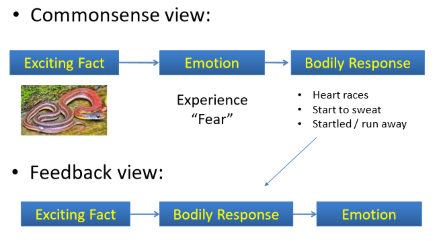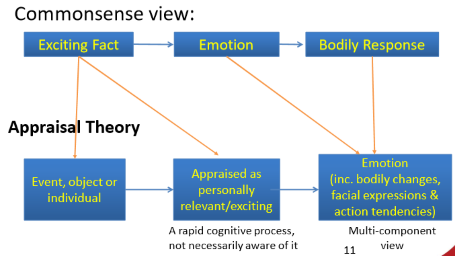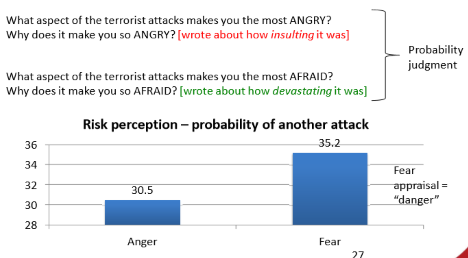Social Psychology of emotions 1
1/26
There's no tags or description
Looks like no tags are added yet.
Name | Mastery | Learn | Test | Matching | Spaced |
|---|
No study sessions yet.
27 Terms
What is an emotion?
Multi-componential and different from a mood:
Brief
Arousal: involve physiological changes e.g. sweaty pals, heart rate, blush, facial movements, goose bumps
Appraisal: specific, “aboutness” (has an eliciting event)
Motivate action to help with individual and social goals
Emotions involve physiological changes
Silvers & Haidt (2008)
Recent mothers watched a funny or inspiring film
Roughly 50% reported no arousal
Others experienced crying, goosebumps, induced nursing and warmth in chest
Feedback theory (James, 1884)
James contrasts his feedback theory with what our commonsense understanding might tell us about the causes of our emotional experiences
Something happens to your body, recognise that and show the emotion

Two-factor “appraisal” theory (Schacter, 1962)
Construal of the world that allows them to label and differentiate their experiences
E.g. immediate stimulus (adrenaline injected) - bodily response (arousal - heart rate increase) - appraisal of context (other person is irritating or funny) - subjective emotion (angry or happy)

Other appraisal theories (Arnold, 1960)
Appraisal theories are closer to what James labelled our ‘common-sense’ understanding of emotion
Propose that emotions are brouhgt about when some ‘thing’ in the world (event, object, person, group) is appraised as in someway important, relevant, or exciting to us
Cognitive aspect of emotions

Fast and slow appraisals in the brain (Ledoux, 1996 - The emotional brain)
Danger-detection system
Low-road = thalamus to amygdala pathway (unconscious appraisal)
Fast but makes lots of errors e.g. reacts to ‘snake-like’ objects
High-road = thalamus to sensory cortex (conscious appraisal)
Slow but accurate e.g. “it’s just a tree branch”
This model may be specific to threats/fear and relating to coping events
Appraisal theory: Smith & Lazarus, 1993
Primary appraisal (elicit arousal and engage attention - low road)
Motivational relevance -is it relevant to me or not?
Motivational congruence - is it consistent with my goals or not?
Secondary appraisals (assess available resources and coping options - high road) - regulating and understanding more about the event
Accountability/agency - is someone/thing else to blame or am I?
Problem focused coping potential - can I do something to bring this in line with my interests?
Emotion focused coping potential - can I change how I think or feel about this?
Future expectancy - is this situation likely to change for better or worse?
Conceptual Act Model of Emotion (Barrett, 2006)
People construct emotions from:
Core affect (arousal and valence) AND
Conceptual knowledge of which emotion occurs in which circumstances (akin to appraisals)
E.g. fear is I’m feeling threatened or the person looked angry; anger if I’m feeling I was treated unfairly
People construct their emotion experiences by attending to different aspects of the situation (individual differences)
Are there basic emotions?
There is a view that there are a small number of basic emotions (natural kinds), biologically hard-wired by evolutionary processes into the brains and nervous systems of all human, scross cultures and history
One list includes: happiness, sadness, anger, fear, surprise, and disgust - each with their own unique facial expression, physiological profile and antecedents
All other emotions, according to basic emotion theorists, are secondary emotions i.e. blends of these basc emotions e.g. contempt is a blend of disgust and anger
“Universal” Emotion Expressions
Ekman & Friesen (1971)
Japan, Brazil, Argentina, Chile, and USA posed facial expressions
Participants had to give faces description from 6 emotion terms
80-90% accuracy
Could you reliably identify the m=emotion if not given list?
Identifying emotion is context dependent
Context dominates our perception of emotion (Carroll & Russell, 1996)
Gives the perceiver more information than the face alone
Knowledge of the context helps disambiguate the expression - e.g. uncropping a photo or editing someone in different location
Basic emotions?
Context dominates our interpretation of emotion displays (Carroll & Russell, 1996)
Accuracy decreases significantly when spontaneously generated facial expressions are used (“posed” expressions may be symbols rather than signals that represent the true state of the emoter) - not actually experiencing these emotions
People’s facial expressions differ significantly within prototypic emotion-eliciting events (Russell et al., 2003)
No clean neural or physiological distinction between different reported ‘emotions’ - e.g., amygdala activity responds to arousal levels across fear, happiness, and sadness scenarios
How do emotions affect our behaviour and judgement?
Feelings as information (Schwartz, 1990)
Appraisal carryover (Lerner et al., 2004)
Emotion induced short term changes in behaviour can have long term efefcts (via the formation of behavioural routines) e.g. you feel angry about your friend not paying you back, so next time they ask you for a favour you decline, this distrust of your friend can become routine even when the anger dissipates
Feeling as information
Affect heuristic: We use preexisitng feelings to inform novel and complex judgements
Respondents reported lower life satisfaction when it was overcast but only when they weren’t attending to the weather
Affected their emotions when not asked about the weather
Don’t realise to discount the role of weather in their judgement
Appraisal carryover
Not only arousal, appraisals can incidentally influence our judgements

When do emotions inform judgements?
When not really attending to it - otherwise people discount their emotion as influencing their judgement
When the judgement is complex (Forgas, 2000) - Not so much when the judgement is simple or preexisting knowledge is available to guide judgement e.g. do you want oat milk in your coffee?
Social functionalist accounts of emotion
Keltner & Haidt, 1999
Emotions are functional (instrumental and communicative), not just for the individual but for social systems - help people achieve goals
Emotions as functional at four levels:
Individual
Dyadic (interpersonal)
Group (within and between groups)
Cultural
What functions do emotions serve at an interpersonal level?
Keltner & Haidt (1999) suggested that at an interpersonal level emotional responses:
Help individuals know ohers’ emotions, beliefs and intentions (communicative function, modulated by presence of others)
Evoke complementary and reciprocal emotions in others (emotional contagion)
Serve as incentives or deterrents for other individuals’ social behaviour
Emotional expressions are social phenomena 1
Facial expressions as communicative displays (Fridlund, 1991)
Facial expressions communicate adaptively relevant information to others (often involuntarily)
E.g. disgust face arguably communicates distaste or the presence of noxiosu stimulus
Consequently, such expressions have been maintained by evolutionary processes (e.g. muscle structures in the face) - because of how important it is to attnd to that
So too is the ability to decode the meaning of facial expressions - though not without errors (context dominance)
Emotional expressions are social phenomena
Social regulation of facial expressions (Manstead & Fischer, 2001)
Oftentimes it may not benefit us to communicate our behavioural intentions to others
Emotion regulation depends on how we think others will appraise our expressions
E.g. if someone has bad BO you might suppress disgust face and offer a plite, non)Duchenne (‘posed’) smile
Emotional expressions modulated by presence of others: Evidence?
Audience effects
Kraut & Johnston (1979): Ten-pin bowlers and smiling
Meadured the frequency with which bowlers: smiled both when they were facing the pins and when they were facing their friends
From 116 observations there were 36 smiles when bowler faced friend and just 4 when facing the pins
Further, smiling was independent of the score achieved (even though the score should be the smile-eliciting event at the individual level)
Demonstrates that smiling is a social display
Another sudy where olympic medal ceremonies were examined people smiled the most when they received their mdelas - people smile more in interpersonal situations
Evokes reciprocal and complementary emotions
Emotion contagion (Hatfield et al., 1994) - reciprocal emotion expression
Simply hearing people laug can induce smiles and laughter (Provine, 1992)
Moderated by affiliation/interpersonal characteristics
More likely to blush when we see a friend blush than stranger (Shearn et al., 1992)
Roommates who reacted similarly to emotional film clips had closer friendships over one year
Emotion contagion: how does it work?
Hatfield et al., 1994
We are constantly monitoring the facial expressions and non-verbal behaviours of others
If nothing else gets in the way, then emotion contagion works in a similar way to feedback theory: we see someone else smiling, we smile in return, we perceive our smiling and so interpret this as meaning that we feel happy
Anger: An interpersonal emotion?
Keltner & Haidt’s (1999) criteria:
Help individuals know others’ emotions, beliefs and intentions
Evoke complementary and reciprocal emotions in others
Serve as incentives or deterrents for other individuals’ social behaviour
Does anger meet these functional criteria?
Anger expressions
Expressed anger:
Makes our beliefs and intentions clear
Anger is associated antagonism, aggression, retribution, and disapproval (“action tendencies”; Frijda, 1986)
The presence of an anger expression enhances belief that someone disapproves of an action; not as true for disgust (Piazza and Landy, 2020)
Anger evokes reciprocal and complementary responses
Recall
Primary appraisals concern motivational relevance and congruence:
Relevance: Does the persons’s anger matter to you?
Congruence: Is it at odds with what you’re doing?
Secondary appraisals concerns e.g. accountability:
Who is to blame for their anger?
Them: causes you anger (reciprocal emotion)
You: causes you guilt or fear (complimentary emotion)
Anger acts as deterrent for other individuals’ social behaviour
Two findings:
High-power individuals who display anger are more likely to get their way and prompt subordiante, appeasement displays, making them less vulnerable to exploitation
People infer ‘power’ from anger displays and often reats with ference/appeasement (Tiedens, 2001)